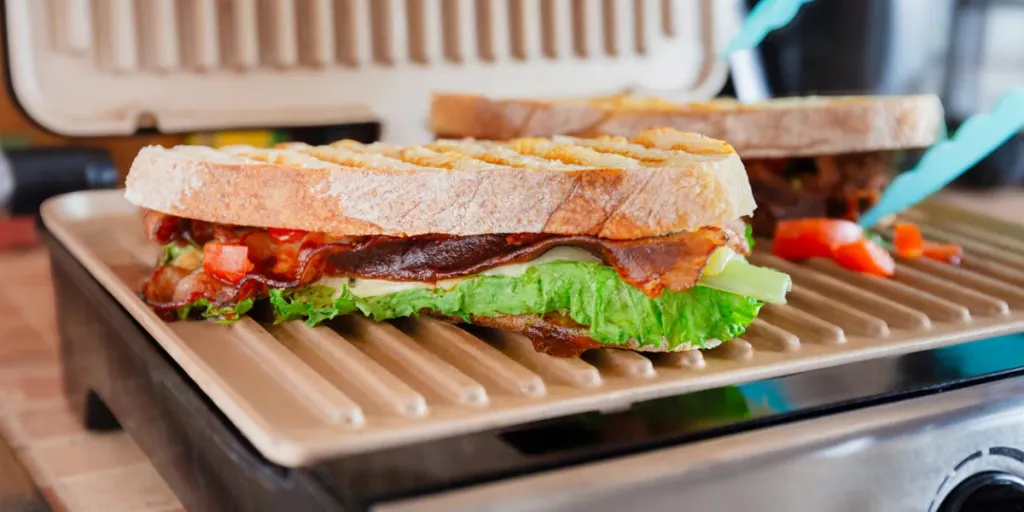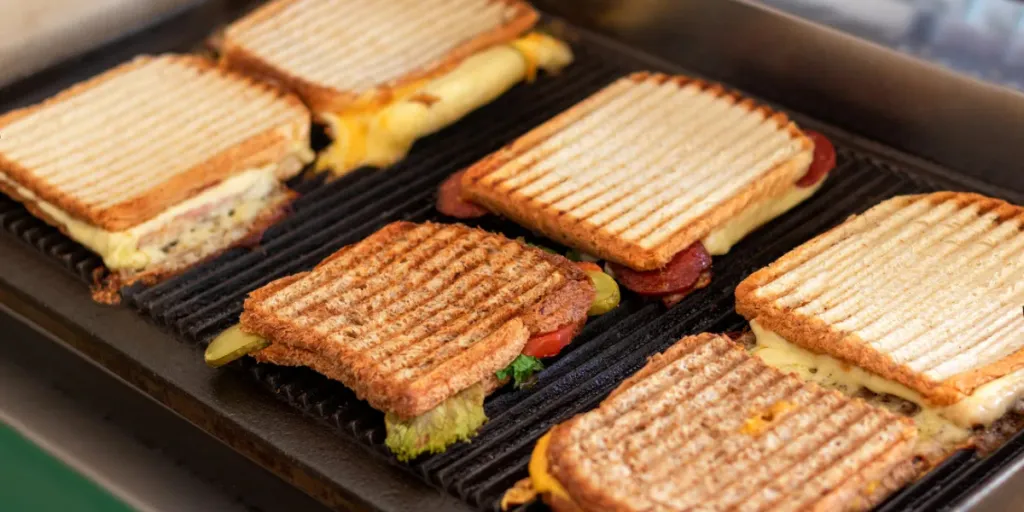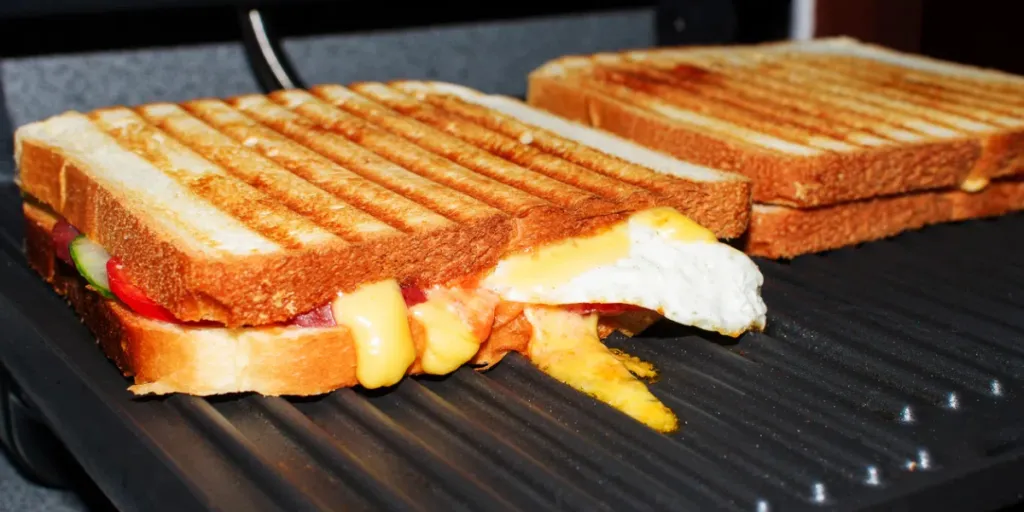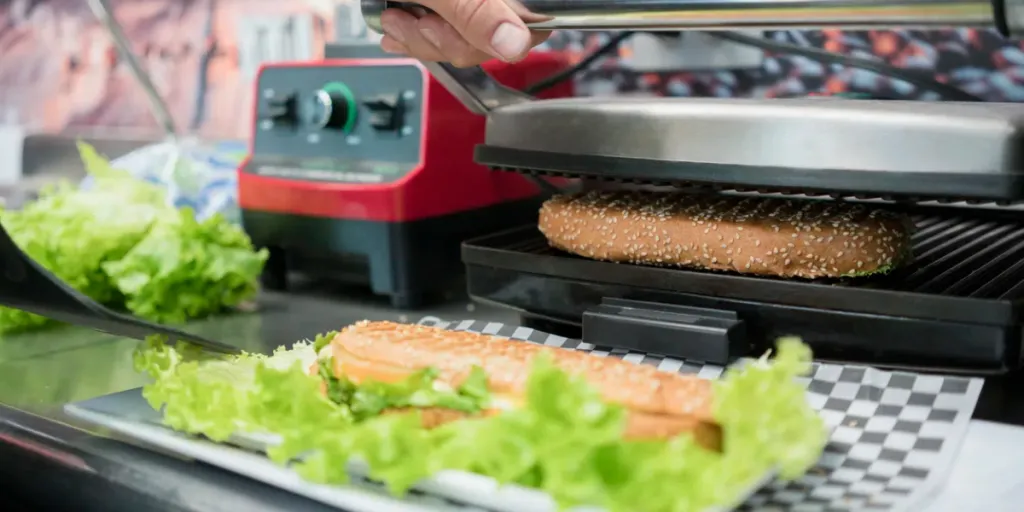The global revenue for grills and roasters was worth about $3.38 billion in 2024, driven by the rising demand in quick-service restaurants and cafes. As the market continues to grow, selecting the right commercial panini grill becomes crucial for business buyers looking to meet consumer preferences and enhance operational efficiency.
Table of Contents:
Understanding the Demand for Commercial Panini Grills
Types of Commercial Panini Grills
Key Features to Consider When Selecting a Commercial Panini Grill
Evaluating the Quality and Durability
Trends in Commercial Panini Grills
Making the Final Decision
Understanding the Demand for Commercial Panini Grills

Key Market Drivers
The demand for commercial panini grills is driven by several key factors. One significant driver is the increasing popularity of quick-service restaurants (QSRs) and cafes, which rely heavily on efficient cooking equipment. According to Statista, the global revenue for grills and roasters is projected to reach US$3.38 billion in 2024, with a compound annual growth rate (CAGR) of 5.80% from 2024 to 2029. This growth is indicative of the rising demand for commercial cooking appliances, including panini grills.
Another crucial driver is the growing consumer preference for grilled and toasted sandwiches, which are perceived as healthier and more flavorful options. The average revenue per user (ARPU) in the grills and roasters market is expected to amount to US$14.16 by 2029, reflecting the increasing consumer spending on these products. Additionally, the trend towards healthier eating habits and the demand for high-quality, freshly prepared food are pushing restaurants and cafes to invest in advanced grilling equipment.
Technological advancements in commercial panini grills are also propelling market growth. Modern grills come with features such as adjustable temperature controls, non-stick surfaces, and even digital interfaces for precise cooking. These innovations enhance the efficiency and versatility of panini grills, making them more attractive to commercial buyers. The number of users in the grills and roasters market is expected to reach 353.5 million by 2029, highlighting the expanding user base for these advanced appliances.
Regional Market Analysis
The United States is the largest market for grills and roasters, with a projected revenue of US$2.66 billion in 2024. The market is expected to grow at a CAGR of 4.53%, reaching US$3.32 billion by 2029. This substantial market size is driven by the high number of quick-service restaurants and cafes in the country, which are major consumers of commercial panini grills. User penetration in the U.S. market is expected to increase from 7.3% in 2024 to 9.9% by 2029.
In Europe, countries like France and Germany are also significant markets for commercial panini grills. The revenue in the French market is projected to reach US$15.29 million in 2024, with a CAGR of 6.27% from 2024 to 2029. Similarly, the German market is expected to generate US$21.35 million in 2024, growing at a CAGR of 5.72% to reach US$28.19 million by 2029. These markets are driven by the strong café culture and the increasing number of foodservice establishments.
The Asia-Pacific region, particularly Australia, is experiencing rapid growth in the grills and roasters market. Revenue in the Australian market is projected to reach US$16.57 million in 2024, with an impressive CAGR of 11.57% from 2024 to 2029. This growth is fueled by the rising number of cafes and restaurants, as well as the increasing popularity of Western-style cuisine. User penetration in Australia is expected to rise from 5.7% in 2024 to 7.7% by 2029.
Industry Growth Projections
The commercial panini grill market is poised for significant growth in the coming years. The global revenue for grills and roasters is expected to reach US$4.48 billion by 2029, up from US$3.38 billion in 2024. This growth is driven by the increasing number of foodservice establishments and the rising consumer demand for grilled and toasted sandwiches. The number of users in the market is projected to grow from 353.5 million in 2024 to 4.8% by 2029.
In the United States, the market volume for grills and roasters is expected to reach US$3.32 billion by 2029, with user penetration increasing to 9.9%. This growth is supported by the high number of quick-service restaurants and cafes, which are major consumers of commercial panini grills. The average revenue per user (ARPU) in the U.S. market is expected to amount to US$111.90 by 2029, reflecting the increasing consumer spending on these products.
The European market is also expected to see substantial growth, with revenue in France and Germany projected to reach US$20.72 million and US$28.19 million, respectively, by 2029. The CAGR for these markets is 6.27% and 5.72%, respectively, indicating steady growth driven by the strong café culture and the increasing number of foodservice establishments. The number of users in the French market is expected to reach 3.3 million by 2029, while the German market is projected to have 3.4 million users.
Types of Commercial Panini Grills

Contact Grills
Contact grills are one of the most popular types of commercial panini grills. These grills feature two heated plates that press and cook the sandwich from both sides simultaneously. This design ensures even cooking and creates the characteristic grill marks on the bread. Contact grills are highly efficient and can cook a sandwich in just a few minutes, making them ideal for busy foodservice establishments.
The market for contact grills is driven by their versatility and ease of use. These grills can be used to prepare a variety of foods, including sandwiches, burgers, and vegetables. The adjustable temperature controls and non-stick surfaces make them user-friendly and easy to clean. According to Statista, the global revenue for grills and roasters is projected to reach US$3.38 billion in 2024, reflecting the strong demand for versatile cooking equipment like contact grills.
Technological advancements have further enhanced the functionality of contact grills. Modern models come with features such as digital temperature controls, programmable settings, and even Bluetooth connectivity. These innovations allow for precise cooking and greater control over the grilling process. The number of users in the grills and roasters market is expected to reach 353.5 million by 2029, highlighting the expanding user base for advanced contact grills.
Clamshell Grills
Clamshell grills are another popular type of commercial panini grill. These grills feature a hinged top plate that can be lifted and lowered to press and cook the sandwich. The clamshell design allows for even cooking and creates the characteristic grill marks on the bread. Clamshell grills are highly efficient and can cook a sandwich in just a few minutes, making them ideal for busy foodservice establishments.
The market for clamshell grills is driven by their efficiency and ease of use. These grills can be used to prepare a variety of foods, including sandwiches, burgers, and vegetables. The adjustable temperature controls and non-stick surfaces make them user-friendly and easy to clean. According to Statista, the global revenue for grills and roasters is projected to reach US$3.38 billion in 2024, reflecting the strong demand for efficient cooking equipment like clamshell grills.
Technological advancements have further enhanced the functionality of clamshell grills. Modern models come with features such as digital temperature controls, programmable settings, and even Bluetooth connectivity. These innovations allow for precise cooking and greater control over the grilling process. The number of users in the grills and roasters market is expected to reach 353.5 million by 2029, highlighting the expanding user base for advanced clamshell grills.
Floating Hinge Grills
Floating hinge grills are a versatile type of commercial panini grill. These grills feature a top plate that can be adjusted to accommodate sandwiches of varying thicknesses. The floating hinge design ensures even cooking and creates the characteristic grill marks on the bread. Floating hinge grills are highly efficient and can cook a sandwich in just a few minutes, making them ideal for busy foodservice establishments.
The market for floating hinge grills is driven by their versatility and ease of use. These grills can be used to prepare a variety of foods, including sandwiches, burgers, and vegetables. The adjustable temperature controls and non-stick surfaces make them user-friendly and easy to clean. According to Statista, the global revenue for grills and roasters is projected to reach US$3.38 billion in 2024, reflecting the strong demand for versatile cooking equipment like floating hinge grills.
Technological advancements have further enhanced the functionality of floating hinge grills. Modern models come with features such as digital temperature controls, programmable settings, and even Bluetooth connectivity. These innovations allow for precise cooking and greater control over the grilling process. The number of users in the grills and roasters market is expected to reach 353.5 million by 2029, highlighting the expanding user base for advanced floating hinge grills.
Key Features to Consider When Selecting a Commercial Panini Grill

Grill Surface Material
The grill surface material is a critical factor in the performance and longevity of a commercial panini grill. Stainless steel and cast iron are the most common materials used. Stainless steel is known for its durability and ease of cleaning, while cast iron provides superior heat retention and even cooking. Some high-end models feature non-stick coatings, which can reduce the need for excessive oil and make cleaning easier.
Temperature Control Options
Temperature control is essential for achieving consistent cooking results. Commercial panini grills typically offer either manual or digital temperature controls. Manual controls are straightforward and reliable, while digital controls provide precise temperature settings and often include programmable features. Advanced models may also feature dual-zone temperature controls, allowing different temperatures on each side of the grill for versatile cooking.
Size and Capacity
The size and capacity of a commercial panini grill should match the volume of food service operations. Smaller units with a single grilling surface are suitable for cafes and small restaurants. Larger models with multiple grilling surfaces can handle higher volumes, making them ideal for busy kitchens. It’s important to consider the available counter space and the grill’s footprint to ensure it fits seamlessly into the kitchen layout.
Ease of Cleaning
Ease of cleaning is a significant consideration for maintaining hygiene and efficiency in a commercial kitchen. Removable grill plates are a desirable feature, as they can be easily detached and cleaned separately. Some models also offer drip trays to collect excess grease and crumbs, simplifying the cleaning process. Non-stick surfaces can further reduce cleaning time and effort, but they require careful handling to avoid damage.
Energy Efficiency
Energy efficiency is increasingly important in commercial kitchens, both for cost savings and environmental impact. Look for panini grills with energy-saving features such as automatic shut-off and energy-efficient heating elements. Some models are designed to heat up quickly and maintain consistent temperatures with minimal energy consumption. Energy Star-rated appliances are a good indicator of high energy efficiency standards.
Evaluating the Quality and Durability

Build Quality
The build quality of a commercial panini grill directly affects its performance and lifespan. High-quality grills are typically constructed from robust materials like stainless steel and heavy-duty cast iron. These materials resist wear and tear, ensuring the grill can withstand the rigors of a busy kitchen. Additionally, well-built grills often feature reinforced hinges and sturdy handles to support frequent use.
Warranty and Support
Warranty and support are crucial factors in evaluating the reliability of a commercial panini grill. A comprehensive warranty can provide peace of mind, covering parts and labor for a specified period. Look for manufacturers that offer at least a one-year warranty, with some high-end models providing up to three years of coverage. Reliable customer support is also essential for troubleshooting and obtaining replacement parts quickly.
Brand Reputation
Brand reputation can be a strong indicator of the quality and reliability of a commercial panini grill. Established brands with a history of producing durable and efficient kitchen equipment are often a safer investment. Researching customer reviews and industry ratings can provide insights into the performance and longevity of different models. Brands known for their innovation and customer service are typically preferred by professional kitchens.
Trends in Commercial Panini Grills

Technological Innovations
Technological innovations are transforming the commercial panini grill market. Smart grills with IoT connectivity allow for remote monitoring and control via mobile apps. These advanced models can provide real-time data on cooking times and temperatures, enhancing efficiency and consistency. Additionally, some grills now feature touch-screen interfaces and programmable cooking cycles, streamlining operations in busy kitchens.
Sustainability and Eco-Friendly Options
Sustainability and eco-friendly options are becoming increasingly important in the commercial kitchen equipment market. Manufacturers are developing panini grills with energy-efficient components and recyclable materials. Some models incorporate eco-friendly features such as low-energy consumption modes and biodegradable non-stick coatings. These advancements not only reduce environmental impact but also appeal to eco-conscious consumers and businesses.
Making the Final Decision

When making the final decision, consider the specific needs of your kitchen and the features that will provide the most value.




